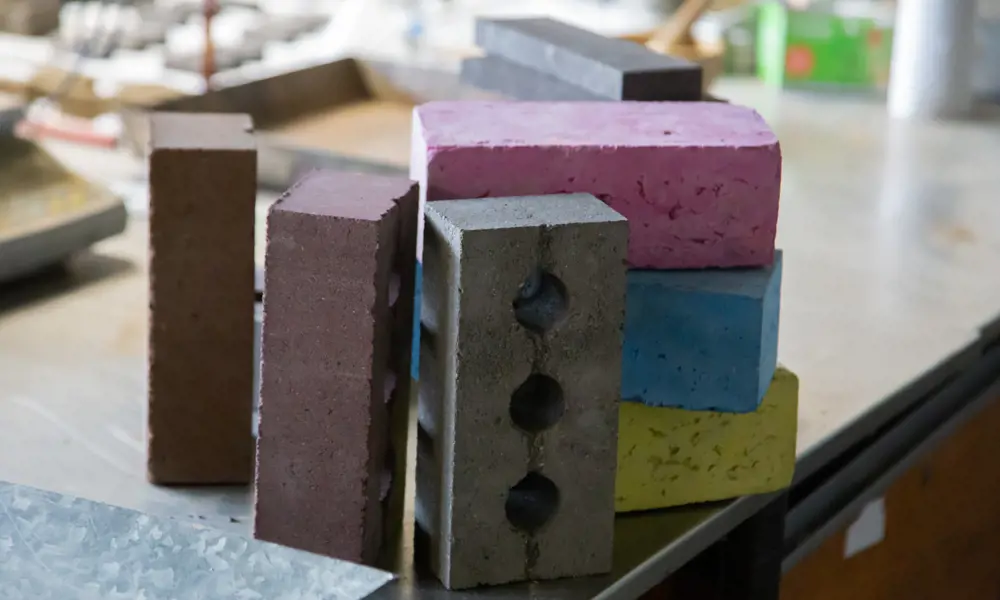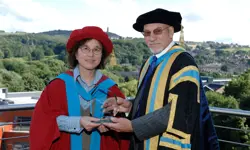
Another brick in the wall
In 2019, the UK made two billion bricks but still needed to import an additional 600 million. The UK government’s new house-building targets are increasing demand for new building materials, but many construction products are unsustainable and more than 30% of landfill waste comes from the construction and demolition of buildings.
Kenoteq, a Heriot-Watt University spinout, has used this construction and demolition waste to create a sustainable building product that is formed of over 90% recycled materials. The K-Briq looks and behaves like a clay brick and weighs the same but offers better insulation properties. The bricks don’t need to be fired, so produce just 10% of the carbon emissions that standard fired bricks create. At the end of their life, the bricks can be ground back down to create new K-Briqs, beginning the cycle again.
The company arose from a partnership between Dr Sam Chapman, a structural engineer with an interest in carbon footprinting and engineering professor Gabriela Medero. Professor Medero had been thinking about how construction materials could be reused for more than 10 years, with an aim to create a more circular economy in construction. Having just completed a PhD in carbon assessment of wind power, Dr Chapman stepped in to carry out a carbon assessment of the potential product and looked at the lifecycle carbon emissions. The pair then applied for a Royal Academy of Engineering Enterprise Fellowship with their prototype to develop and support commercialisation of the product.

A bar stand made of K-Briq modules © Kenoteq
Kenoteq set up its pilot production onsite with a waste handling company. Kenoteq collects inert demolition waste, for example old bricks, rubble and gypsum plaster, before mixing the waste with its binder and compressing it into bricks. Recycled pigments can also be added to produce bricks in any colour. By partnering with companies that already deal with construction waste, Kenoteq ensures that it is not adding trucks to the road – the heavy waste comes to the site anyway, and empty trucks going to collect waste from building sites are ideally suited to deposit the finished product in a place that requires it.
The regulatory process involved in bringing a new product to market is understandably extensive and challenging. The main certifying bodies have been guiding the team through the certification process, and the team has conducted extensive testing and development at Heriot-Watt University to ensure that the bricks could meet safety standards.
K-Briq modules were due to make their debut in this year’s Serpentine Pavilion – an annual architectural event. The Pavilion, designed by South African architectural studio Counterspace, is using custom-sized K-Briq modules, allowing Kenoteq to test and experiment with new colours and textures. However, due to the COVID-19 pandemic, the opening has been postponed until 2021.
By the end of the year, Kenoteq is aiming to scale-up its manufacturing capacity to three million bricks a year. It is also aiming to create a brick out of 100% recycled material, and exploring options to expand its product range to other building materials.
***
Since this article, Kenoteq’s has announced their first commercial manufacturing plant which will be producing K-SLIPs and certified K‑BRIQ®s from March 2024.
This article has been adapted from "How does that work - Inductions hobs", which originally appeared in the print edition of Ingenia 83 (June 2020).
Contributors
Sam completed his studied structural engineering with artitectural design before completing his PhD at Heriot-Watt University in carbon assessment of wind power. He is now the Managing Director for Kenoteq.
Gabriela studied a Master of Engineering in Civil Engineering at the Federal University of Rio Grande do Sul and she is now a professor in Geotechnical and Geoenvironmental Engineering at Heriot-Watt University and also the Chief Stratergy Officer for Kenoteq.
Keep up-to-date with Ingenia for free
SubscribeRelated content
Design & manufacturing

Super cool(er)
Welsh startup Sure Chill has developed a cooler that uses the properties of water to keep its contents cool for around 10 days without electricity. This is ideal for storing items such as vaccines where electricity sources are unreliable.

R&D investment makes good business sense
In just five years, Dr Ralf Speth FREng has presided over a revolution in design and manufacturing that has helped create a new family of engines and has overhauled Jaguar Land Rover (JLR) production facilities.

Steel can arise from the ashes of coal
Thousands of people were laid off in the UK steel industry in 2015 and there are pessimistic future forecasts. Professor Sridhar Seetharaman of the Warwick Manufacturing Group argues that smaller, flexible steel mills implementing new technology would better cope with fluctuating global trends.

Integrating metrology in business and academe
Professor Jane Jiang’s interest in measuring began when she worked on a bus production line in China. She found that the best way to improve quality, consistency and productivity was through metrology, the science of measurement. Today, she runs the UK’s largest metrology research group.
Other content from Ingenia
Quick read

- Environment & sustainability
- Opinion
A young engineer’s perspective on the good, the bad and the ugly of COP27

- Environment & sustainability
- Issue 95
How do we pay for net zero technologies?
Quick read

- Transport
- Mechanical
- How I got here
Electrifying trains and STEMAZING outreach

- Civil & structural
- Environment & sustainability
- Issue 95